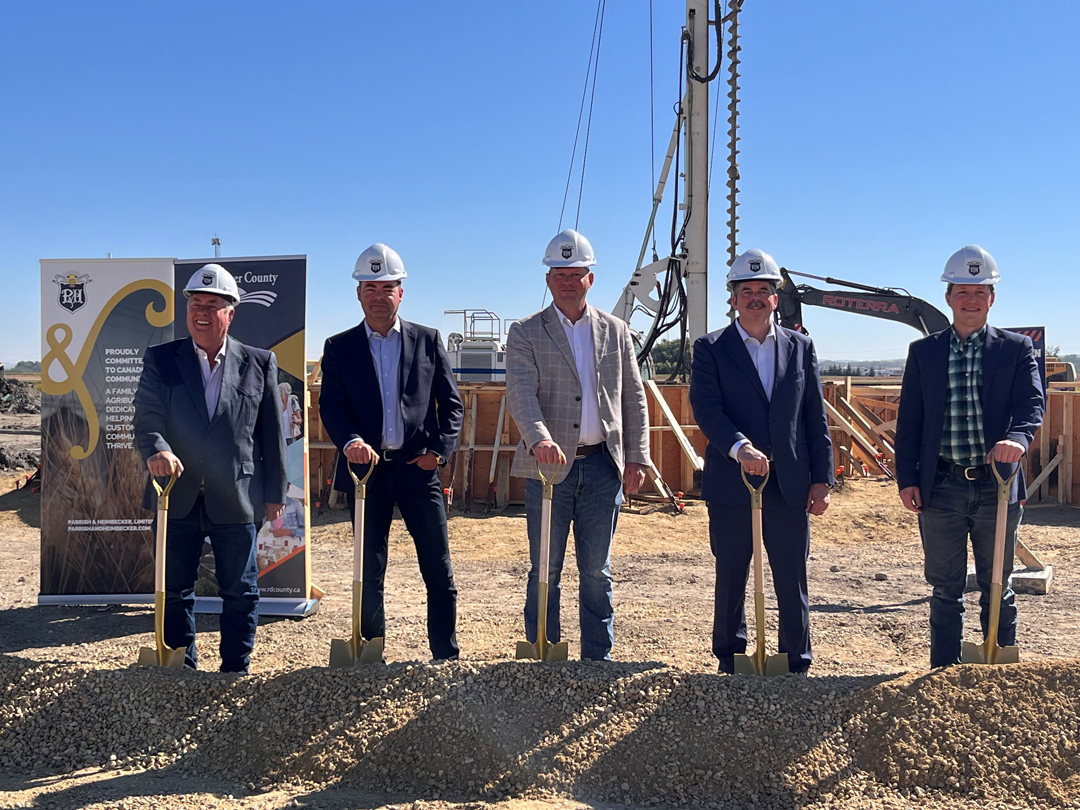P&H BREAKS GROUND AT NEW FLOUR MILL SITE
BY IAN DOIG • PHOTO COURTESY OF ALBERTA AGRICULTURE AND IRRIGATION
While demand for flour products jumped by 24 per cent in Alberta between 2019 and 2022, the province’s exports of wheat and meslin flour also increased to $19.8 million in 2023 from $8.6 million in 2019.
The morning of September 6, P&H Milling Group, a division of Parrish & Heimbecker Limited, held a sod turning for its new $241 million mill site in the Red Deer County hamlet of Springbrook. A family-owned grain and crop input corporation, the parent company was founded in 1909. With a head office in Winnipeg, its group of companies has 1,500 Canadian employees who serve customers in 24 countries. P&H facilities include seven export terminals, seven flour mills and five animal feed sites. The country’s largest miller, P&H Milling Group processes hard red spring wheat, winter wheat and peas.
Under its Agri-Processing Investment Tax Credit (APITC) program, the province has conditionally approved a tax credit of approximately $27.3 million for the project. The APITC provides a 12 per cent non-refundable tax credit to corporations that invest $10 million or more to build or expand a value-added agri-processing facility within the province. The P&H project will create 200 temporary jobs and 27 full-time permanent positions.
The new facility will play a significant role in the company’s milling operations as it will increase the capacity and efficiency of its western Canadian operations, said Mike Warkentin, P&H director of special projects and stakeholder relations. Its primary product will be strong baker’s flour and milling byproducts will be sold into the livestock feed sector.
While the APITC played a part in the company’s choice of Alberta as a base for its expanded western Canadian operations, the province’s significant projected population growth was also a draw. Warkentin said P&H hopes the Alberta facility will positively affect the province’s agri-food processing industry. The launch of the company’s Port of Hamilton flour mill in 2017 sparked just such investment downstream in the commercial baking industry. “Alberta not only has set up a strong logistical network for agriculture processing, it has made a strong commitment to investing in agriculture and ensuring that Alberta has a strong agri-food economy,” he said.
The mill’s Red Deer County location also has the benefit of rail access for shipment to the Edmonton and Calgary markets. Additionally, the site gives P&H the ability to triply expand the mill’s capacity in the future as market growth demands.
The company is scheduled to begin milling wheat at the facility in the fall of 2026. “This facility will provide more opportunity for the western Canadian farmer to get their wheat to market,” said Warkentin. “The more we can support those producers, the better.”
“The fact they’re choosing the hamlet of Springbrook in central Alberta as the new location is such a benefit to the agricultural, agri-processing industry right down to the farmer himself,” said RJ Sigurdson (pictured above, centre), provincial minister of agriculture and irrigation. “This year, we’re going to set a record with $3.2 billion of agri-processing investment in the province of Alberta. We’re seeing so much interest. We really have become a beacon for that type of investment, which will continue to create jobs for Albertans and strengthen our agricultural industry.”
Sigurdson noted global demand for food will increase by at least 50 per cent by 2050, and international trading partners look to Alberta as a potential supplier. “Growing food demand and agri-processing is going to play a huge part in how we can continue to create jobs and grow our economy here in Alberta.”







Comments